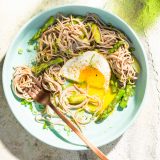Cooking asparagus comes with a built-in challenge. A single spear wants to be treated like two distinct vegetables: a sturdy, fibrous stalk and a feathery, tender tip.
Each segment tastes best when cooked to different degrees, something few cooking methods accommodate. But we came across a promising approach in Nancy Hachisu’s “Japanese Farm Food.”
To cook greens with thick stems and tender leaves, Hachisu holds them by the leaves and briefly dips the stems in boiling water before dropping in the whole bunch. It’s a simple technique that allows the stems to cook longer overall without overcooking the leaves.
We tried this method with asparagus, holding the spears upright so the stalks could get a jumpstart on cooking. But the stalks took a full minute to soften—a long time to stand over boiling water. It was easier to cut and separate the spears into stalks and tips and simply toss the stalks into the water first.
To flavor the asparagus, we stuck with Japan for inspiration. We love the savory-sweet flavor of miso—the fermented bean paste most of us slurp as sushi-restaurant soup—and knew it would complement asparagus. But we needed a fat to draw out and carry those flavors, coating the asparagus.
This time our inspiration came from Momofuku’s David Chang, who blends miso and butter. Chang likes a high miso-to-butter ratio, but we found equal parts of each was just right, particularly when balanced with grated fresh ginger.
Mixed with warm asparagus, the miso butter was delicious, but we wanted something more. So we channeled the buttered pasta dishes of our childhood and added soba noodles, in keeping with the Japanese profile. Plus, the noodles and the asparagus could cook in the same water at the same time.
The dish was just shy of a square meal, so we topped it with a sunny-side up egg. The barely set yolk, pierced with a fork, mixed wonderfully with the miso butter, creating a rich sauce for the noodles and asparagus.
Every stovetop has a different low setting, and skillets vary in thickness and heat conductivity. It may take a few attempts to determine the best timing for your equipment. For us, 3 minutes was perfect for completely set whites and thick but runny yolks.If you like very loose yolks, shave off a minute; for lightly browned whites and firm yolks, add a minute. To make just two eggs, use an 8-inch nonstick skillet and 2 teaspoons of butter.




